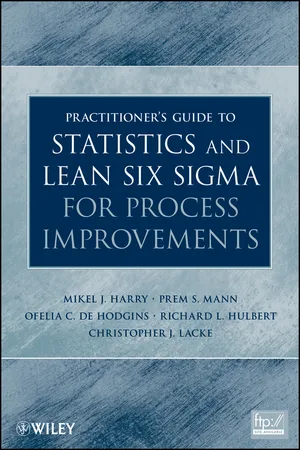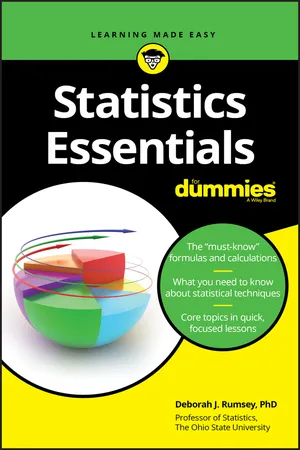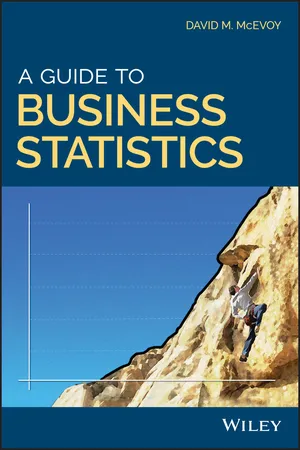Technology & Engineering
Hypothesis Test for a Population Mean
A hypothesis test for a population mean is a statistical method used to make inferences about the true mean of a population based on sample data. It involves formulating a null hypothesis and an alternative hypothesis, collecting sample data, calculating a test statistic, and determining the likelihood of observing the sample mean if the null hypothesis is true. This test helps to assess whether there is enough evidence to support a claim about the population mean.
Written by Perlego with AI-assistance
Related key terms
5 Key excerpts on "Hypothesis Test for a Population Mean"
- Mikel J. Harry, Prem S. Mann, Ofelia C. De Hodgins, Richard L. Hulbert, Christopher J. Lacke(Authors)
- 2011(Publication Date)
- Wiley(Publisher)
16 Single-Population Hypothesis Tests 16.1 OVERVIEW This chapter introduces the second topic in inferential statistics. tests of hypotheses. In a hypothesis test, we test a certain given theory or belief about a population parameter. We may want to find out, using some sample information, whether or not a given claim (or statement) about a population parameter is reasonable. This chapter discusses how to make such tests of hypotheses about the population mean µ and the population proportion p. As an example, a soft-drink company may claim that, on average, its cans contain 12 ounces (oz) of soda. A government agency may want to test whether or not such cans contain, on average, 12 oz of soda. As another example, according to the US Bureau of Labor Statistics, 57.3% of married women in the United States were working outside their homes in 1991. An economist may want to check if this percentage is still reasonable for this year. In the first of these two examples we are to test a hypothesis about the population mean µ, and in the second example we are to test a hypothesis about the population proportion p. 16.2 INTRODUCTION TO HYPOTHESIS TESTING Why do we need to perform a hypothesis test? Reconsider the example about soft-drink cans. Suppose that we take a sample of 100 cans of the soft drink under investigation. We then find out that the mean amount of soda in these 100 cans is 11.89 oz. On the basis of this result, can we state that, on average, all such cans contain less than 12 oz of soda and that the company is lying to the public? Not until we perform a hypothesis test can we make such an accusation. The reason is that the mean = 11. 89 oz is obtained from a sample. The difference between 12 oz (the required average for the population) and 11.89 oz (the observed average for the sample) may have occurred only because of the variability from can to can. Another sample of 100 cans may give us a mean of 12.04 oz- eBook - ePub
- Derek L. Waller(Author)
- 2016(Publication Date)
- Routledge(Publisher)
research hypothesis since it is a value that has been obtained from a sampling experiment.For example, the hypothesis is that the average age of the population in a certain country is 35. This value is the null hypothesis. The alternative to the null hypothesis is that the average age of the population is not 35 but is some other value. In hypothesis testing there are three possibilities. The first is that there is evidence that the value is significantly different from the hypothesized value. The second is that there is evidence that the value is significantly greater than the hypothesized value. The third is that there is evidence that the value is significantly less than the hypothesized value. Note that in these sentences we say there is evidence because as always in statistics there is no guarantee of the result as we are basing our analysis of the population on sampling alone and of course our sample experiment may not yield the correct result. These three possibilities lead to using a two-tailed hypothesis test , a right-tailed hypothesis test , and a left-tailed hypothesis test as explained in the next section.Presenting hypothesis testing for the mean
In hypothesis testing for the mean an assumption is made about the mean or average value of the population. Then we take a sample from this population, determine the sample mean value, and measure the difference between this sample mean and the hypothesized population value. If the difference between the sample mean and the hypothesized population mean is small, then the probability is higher that our hypothesized population mean value is correct. If the difference is large then the probability is lower that our hypothesized value is correct.Two-tailed test
A two-tailed test is used when we are testing to see if a value is significantly different - eBook - ePub
- Deborah J. Rumsey(Author)
- 2019(Publication Date)
- For Dummies(Publisher)
Alpha levels and resulting decisions will vary from researcher to researcher. General steps for a hypothesis test Here’s a boiled-down summary of the steps involved in doing a hypothesis test. (Particular formulas needed to find test statistics for any of the most common hypothesis tests are provided in the rest of this chapter.) Set up the null and alternative hypotheses: and. Take a random sample of individuals from the population and calculate the sample statistics (means and standard deviations). Convert the sample statistic to a test statistic by changing it to a standard score (all formulas for test statistics are provided later in this chapter). Find the p -value for your test statistic. Examine your p -value and make your decision. Testing One Population Mean This test is used when the variable is numerical and only one population or group is being studied. For example, Dr. Phil says that the average time that working mothers spend talking to their children is 11 minutes per day. The variable, time, is numerical, and the population is all working mothers. The null hypothesis in the Dr. Phil example is minutes. Note that represents the average number of minutes per day that all working mothers spend talking to their children, and the claim is that that mean is 11. The alternative hypothesis,, is either:, or. Let’s suppose you suspect that the average time working mothers spend talking with their kids is more than 11 minutes; your alternative hypothesis would be. The formula for the test statistic for one population mean is. To calculate it, do the following: Calculate the sample mean,, and the sample standard deviation, s. Let n represent the sample size. See Chapter 1 for calculations of the mean and standard deviation. Find minus. (Remember, is the claimed value of the population mean.) Calculate the standard error:. Divide your result from Step 2 by the standard error found in Step 3. For the Dr - eBook - ePub
- David M. McEvoy(Author)
- 2018(Publication Date)
- Wiley(Publisher)
Chapter 8 Hypothesis Tests of a Population MeanIn 2010, a business professor at the University of Central Florida confronted the students in his strategic management course about cheating on a mid-term exam.1 The class was huge, with over 600 students. The professor was convinced that roughly 200 students had cheated by getting the answers to the exam in advance. The interesting part is that he had no direct evidence. The exams were proctored in a laboratory environment and not a single student was actively caught cheating. Rather, the professor relied on statistics to drive his initial suspicion. The professor had been teaching the class for many semesters and as part of the discovery process, he conducted hypothesis tests to compare that semester's exam grades with the historic grades from past semesters. He found a significant difference. The difference was so significant that he was confident that the abnormally high grades were not due to random chance. Rather, the difference in exam grades was large enough to strongly suspect foul play. His suspicions were later confirmed by a student who tipped the professor off about students accessing the exam questions online. The guilty students eventually admitted to cheating and the entire class was required to take a new exam. While statistical analysis was not the only thing used to confirm the suspicion of cheating, the results of hypothesis testing triggered further inquiry.The real power of statistics is being able to use samples of data to infer something unknown about a larger population. We explored one aspect of this in Chapter 7 on confidence intervals. Here, we move onto using sample data to test hypotheses regarding the larger population. We start with the simplest case in which we use one sample of data to test a single numeric value regarding the population. Some good examples are hypothesis tests for quality control of products and services. Starbucks, for example, reports that a 16 oz cup of regular coffee (the grande size of Pike Place) has 310 milligrams (mgs) of caffeine.2 Of course, there is going to be some variation in the actual amount of caffeine found in every grande cup of coffee brewed across the United States and abroad. The caffeine content can depend on the water quality, how long the beans have been roasted, the age of the beans, the skillset of the barista, the type of filter, and many other things. Therefore, we would not expect every single 16 oz cup to have exactly 310 mg of coffee. Given this variation, it is possible to sample a number of cups of coffee to test whether the average - eBook - ePub
- Richard A. DeFusco, Dennis W. McLeavey, Jerald E. Pinto, David E. Runkle, Mark J. P. Anson(Authors)
- 2015(Publication Date)
- Wiley(Publisher)
- The statistical decision consists of rejecting or not rejecting the null hypothesis. The economic decision takes into consideration all economic issues pertinent to the decision.
- The p-value is the smallest level of significance at which the null hypothesis can be rejected. The smaller the p-value, the stronger the evidence against the null hypothesis and in favor of the alternative hypothesis. The p-value approach to hypothesis testing does not involve setting a significance level; rather it involves computing a p-value for the test statistic and allowing the consumer of the research to interpret its significance.
- For hypothesis tests concerning the population mean of a normally distributed population with unknown (known) variance, the theoretically correct test statistic is the t-statistic (z-statistic). In the unknown variance case, given large samples (generally, samples of 30 or more observations), the z-statistic may be used in place of the t-statistic because of the force of the central limit theorem.
- The t-distribution is a symmetrical distribution defined by a single parameter: degrees of freedom. Compared to the standard normal distribution, the t-distribution has fatter tails.
- When we want to test whether the observed difference between two means is statistically significant, we must first decide whether the samples are independent or dependent (related). If the samples are independent, we conduct tests concerning differences between means. If the samples are dependent, we conduct tests of mean differences (paired comparisons tests).
- When we conduct a test of the difference between two population means from normally distributed populations with unknown variances, if we can assume the variances are equal, we use a t
Learn about this page
Index pages curate the most relevant extracts from our library of academic textbooks. They’ve been created using an in-house natural language model (NLM), each adding context and meaning to key research topics.




